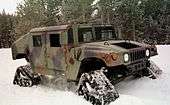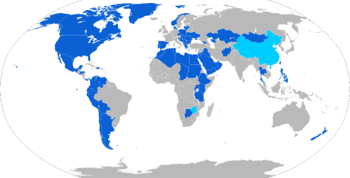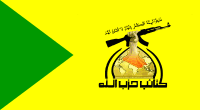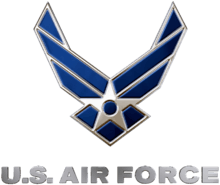Humvee
| High Mobility Multipurpose Wheeled Vehicle (HMMWV) | |
|---|---|
|
| |
| Type |
Unarmored: Light Utility Vehicle Armored: Light Armored Car |
| Place of origin | United States |
| Service history | |
| In service | 1984–present |
| Production history | |
| Manufacturer | AM General |
| Unit cost | $220,000 (2011) (up-armored)[1] |
| Produced | 1984–present |
| Number built | 281,000[2] |
| Specifications | |
| Weight | 5,200–5,900 lb (2,359–2,676 kg) curb weight[3] |
| Length | 15 ft (4.57 m),[4] wheelbase 10 ft 10 in (3.30 m) |
| Width | 7 ft 1 in (2.16 m)[4] |
| Height | 6 ft (1.83 m), reducible to 4 ft 6 in (1.37 m)[4] |
|
| |
Main armament | see text |
| Engine |
V8 diesel 6.2 L (380 cu in) or V8 turbo diesel 6.5 L (400 cu in): 190 hp (142 kW) @ 3,400 rpm / 380 lbf·ft (515 N·m) @ 1,700 rpm[3] |
| Transmission | 3-speed automatic or 4-speed automatic[3] |
| Suspension | Independent 4×4 |
| Fuel capacity | 25 U.S. gal (95 L)[4] |
| Speed |
55 mph (89 km/h) at max gross weight[5] Over 70 mph (113 km/h) top speed[3][6] |
The High Mobility Multipurpose Wheeled Vehicle (HMMWV), commonly known as the Humvee, is a four-wheel drive military light truck produced by AM General.[7] It has largely supplanted the roles previously performed by the original jeep, and others such as the Vietnam-era M151 jeep, the M561 "Gama Goat", their M718A1 and M792 ambulance versions, the Commercial Utility Cargo Vehicle (CUCV), and other light trucks. Primarily used by the United States military, it is also used by numerous other countries and organizations and even in civilian adaptations. The Humvee's widespread use in the Gulf War of 1991, where it negotiated the treacherous desert terrain, helped inspire civilian Hummer versions.
History
Since the WWII era Bantam Reconnaissance Car, the United States Army had relied on jeeps to transport small groups of soldiers. The jeep was built around a requirement for a compact vehicle with a folding windshield that was actually shorter than the Volkswagen Beetle. It seated three with a 660 lb (300 kg) payload and weighed just over one ton. By the 1970s, the U.S. Army had tried larger militarized civilian trucks, but even these no longer satisfied newer requirements. In 1977, Lamborghini developed the Cheetah model in an attempt to meet the Army contract specifications.
In 1979, the U.S. Army drafted final specifications for a High Mobility Multipurpose Wheeled Vehicle, or HMMWV, which was to replace all the tactical vehicles in the 1/4 to 1 1/4-ton range,[8] namely the M151 quarter-ton jeep and M561 Gama Goat, as one "jack-of-all-trades" light tactical vehicle to perform the role of several existing trucks.[9] The specification called for excellent on and off-road performance, the ability to carry a large payload, and improved survivability against indirect fire.[10] Compared to the jeep, it was larger and had a much wider track, with a 16 in (410 mm) ground clearance, double that of most sport-utility vehicles. The new truck was to climb a 60 percent incline and traverse a 40 percent slope. The air intake was to be mounted flush on top of the right fender (or to be raised on a stovepipe to roof level to ford 5 ft (1.5 m) of water[11] and electronics waterproofed to drive through 2.5 ft (0.76 m) of water were specified. The radiator was to be mounted high, sloping over the engine on a forward-hinged hood.
Out of 61 companies that showed interest, only three submitted prototypes.[10] In July 1979, AM General (a subsidiary of American Motors Corporation) began preliminary design work. Less than a year later, the first prototype was in testing; Chrysler Defense and Teledyne Continental also produced competing designs. In June 1981, the Army awarded AM General a contract for development of several more prototype vehicles to be delivered to the government for another series of tests. The original M998 A0 series had a curb weight of 5,200 lb (2,400 kg). with a payload of 2,500 lb (1,100 kg), with a 6.2 L (380 cu in) V-8 diesel engine and a three-speed automatic transmission.
The three companies were chosen to design and build eleven HMMWV prototypes, which covered over 600,000 miles in trials which included off-road courses in desert and arctic conditions. AM General was awarded an initial contract in 1983 for 2,334 vehicles, the first batch of a five-year contract that would see 55,000 vehicles delivered to the U.S. military, including 39,000 for the Army; 72,000 vehicles had been delivered to U.S. and foreign customers by the 1991 Gulf War, and 100,000 were delivered by the Humvee's 10th anniversary in 1995.[9] Ft. Lewis, Washington and the 9th Infantry Division was the testing unit to employ HMMWV in the new concept of a motorized division. Yakima Training Center in Yakima, Washington was the main testing grounds for HMMWVs from 1985 through December 1991, when the motorized concept was abandoned and the division inactivated.
Usage in combat
HMMWVs first saw combat in Operation Just Cause, the U.S. invasion of Panama in 1989.
The HMMWV was designed primarily for personnel and light cargo transport behind front lines, not as a front line fighting vehicle. Like the previous jeep, the basic HMMWV has no armor or protection against chemical, biological, radiological or nuclear threats. Nevertheless, losses were relatively low in conventional operations, such as the Gulf War. Vehicles and crews suffered considerable damage and losses during the Battle of Mogadishu due to the nature of the urban engagement; however, the chassis survivability allowed the majority of those crews to return to safety, though the HMMWV was never designed to offer protection against intense small arms fire, much less machine guns and rocket-propelled grenades. However, with the rise of asymmetric warfare and low intensity conflicts, the HMMWV was pressed into service in urban combat roles for which it was not originally intended.
After Operation Restore Hope in Somalia, the military recognized a need for a more protected HMMWV and AM General developed the M1114, an armored HMMWV to withstand small arms fire. The M1114 has been in limited production since 1996, seeing limited use in the Balkans before deployment to the Middle East. This design is superior to the M998 with a larger, more powerful turbocharged engine, air conditioning, and a strengthened suspension system. More importantly, it boasts a fully armored passenger area protected by hardened steel and bullet-resistant glass. With the increase in direct attacks and guerrilla warfare in Iraq, AM General diverted the majority of its manufacturing power to producing these vehicles.
Humvees were sent into Afghanistan following the 9/11 terrorist attacks, where they proved invaluable during initial operations. In the early years before IEDs became prevalent, the vehicle was liked by troops for its ability to access rough, mountainous terrain. Some soldiers would remove features from Humvees, including what little armor it had and sometimes even entire doors, to make them lighter and more maneuverable for off-road conditions and to increase visibility. With the onset of the Iraq War, Humvees proved very vulnerable to IEDs; in the first four months of 2006, 67 U.S. troops died in Humvees. To increase protection, the U.S. military hastily added-on armor kits to the vehicles. Although this somewhat improved survivability, bolting on armor made the Humvee an "ungainly beast," increasing weight and putting strain on the chassis, which lead to unreliability. Armored doors that weighed hundreds of pounds were difficult for troops to open and the newly armored turret made Humvees top heavy and increased the danger of rollovers. The U.S. Marine Corps decided to start replacing Humvees in combat with MRAPs in 2007, and the U.S. Army stated that the vehicle was "no longer feasible for combat" in 2012.[9][10]
The HMMWV has become the vehicular backbone of U.S. forces around the world. Over 10,000 HMMWVs were employed by coalition forces during the Iraq War. The Humvee has been described as "the right capability for its era" to provide payload mobility in protected areas, but that conflicts exposing it to full-spectrum threat environments that it was never designed to operate or be survivable in led to adding protection at the cost of mobility and payload.[9]


Modifications


In December 2004, Secretary of Defense Donald Rumsfeld came under criticism from U.S. troops and their families for not providing better-equipped HMMWVs.[12] Rumsfeld pointed out that, prior to the war, armor kits were produced only in small numbers per year. As the role of American forces in Iraq changed from fighting the Iraqi Army to suppressing the guerrilla insurgency, more armor kits were being manufactured, though perhaps not as fast as production facilities were capable of bringing them online. Even more advanced kits were also being developed. However, while these kits are much more effective against all types of attacks, they weigh between 1,500 to 2,200 lb (680 to 1,000 kg) and have some of the same drawbacks as the improvised armor.[13] Unlike similar-size civilian cargo and tow trucks, which typically have dual rear wheels to reduce sway, the HMMWV has single rear wheels due to its independent rear suspension coupled with the body design.

Most up-armored HMMWVs hold up well against lateral attacks, when the blast is distributed in all different directions, but offers little protection from a mine blast below the truck, such as buried improvised explosive devices (IEDs) and land mines. Explosively formed penetrators (EFPs) can also defeat the armor kits, causing casualties.
The armor kits fielded include the Armor Survivability Kit (ASK), the FRAG 5, FRAG 6, as well as upgrade kits to the M1151.[14][15] The ASK was the first fielded, in October 2003, adding about 1,000 pounds (450 kg) to the weight of the vehicle.[16] Armor Holdings fielded an even lighter kit, adding only 750 pounds (340 kg) to the vehicle's weight.[17] The Marine Armor Kit (MAK), fielded in January 2005, offers more protection than the M1114, but also increases weight.[18] The FRAG 5 offered even more protection but was still inadequate to stop EFP attacks.[19] The FRAG 6 kit is designed to do just that, however its increased protection adds over 1,000 lb (450 kg) the vehicle over the FRAG 5 kit, and the width is increased by 2 feet (61 cm). In addition, the doors may require a mechanical assist device to open and close.[20]
Another drawback of the up-armored HMMWVs occurs during an accident or attack, when the heavily armored doors tend to jam shut, trapping the troops inside.[21] As a result, HMMWVs were fitted with hooks on their doors, so that another vehicle can rip the door off, freeing the troops inside.[22] In addition, Vehicle Emergency Escape (VEE) windows, developed by BAE Systems, were fielded for use on the M1114 uparmored HMMWV, with 1,000 kits ordered.[23]

The soldier manning the exposed crew-served weapon on top of the vehicle is extremely vulnerable. In response, many HMMWVs have been fitted with basic gun shields or turrets, as was the case with M113 APCs after they were first deployed in Vietnam. The U.S. military is currently evaluating a new form of protection, developed by BAE Systems as well as systems designed by the Army, which are already in theater.[24] The new gunner's seat is protected by 1.5 to 2 feet (46 to 61 cm) high steel plates with bullet-proof glass windows. Additionally, some HMMWVs have been fitted with a remotely operated CROWS weapon station, which slaves the machine gun to controls in the back seat so it can be fired without exposing the crew. The Boomerang anti-sniper system was also fielded by some HMMWVs in Iraq to immediately give troops the location of insurgents firing on them.
Another weakness for the HMMWV has proven to be its size, which limited its deployment in Afghanistan because it is too wide for the smallest roads and too large for many forms of air transport compared to jeep or Land Rover-sized vehicles (which are nearly two feet narrower). This size also limits the ability for the vehicle to be manhandled out of situations.
Alternatives
The Army purchased a purpose-built armored car, the M1117 Armored Security Vehicle also known as an armored personnel carrying vehicle (APC), in limited numbers for use by the United States Army Military Police Corps. In 2007, the Marine Corps announced an intention to replace all HMMWVs in Iraq with MRAPs due to high loss rates, and issued contracts for the purchase of several thousand of these vehicles, which include the International MaxxPro, the BAE OMC RG-31, the BAE RG-33 and Caiman, and the Force Protection Cougar,[25][26][27][28][29] which were deployed primarily for mine clearing duties. Heavier models of infantry mobility vehicles (IMV) can also be used for patrol vehicles.[30] The MaxxPro Line has been shown to have the highest rate of vehicle rollover accidents to its very high center of gravity and immense weight. The massive weight of these vehicles combined with their high center of gravity also greatly reduces their utility in off-road situations versus the HMMWV, which was the primary cause for the push for the Oshkosh M-ATV to be developed quickly.
Replacement and future
The Humvee replacement process being undertaken by the U.S. military focused on interim replacement with MRAPs and long-term replacement with the Joint Light Tactical Vehicle (JLTV). The HMMWV has evolved several times since its introduction and was used in tactical roles for which it was never originally intended. The military pursued several initiatives to replace it, both in the short and long terms. The short term replacement efforts utilized commercial off-the-shelf vehicles as part of the Mine Resistant Ambush Protected (MRAP) program. These vehicles were procured to replace Humvees in combat theaters. The long term replacement for the Humvee is the JLTV which is designed from the ground up. The Future Tactical Truck Systems (FTTS) program was initiated to make an analysis of potential requirements for a Humvee replacement. Various prototype vehicles such as the MillenWorks Light Utility Vehicle, and the ULTRA AP have been constructed as part of these efforts. The JLTV contract was awarded to Oshkosh in August 2015.[31]
The U.S. Marine Corps issued a request for proposals (RFP) in 2013 for its Humvee sustainment modification initiative to upgrade 6,700 expanded capacity vehicles (ECVs). The Marines plan to field the JLTV, but do not have enough funding to completely replace all Humvees, so they decided to continue sustaining their fleet. Key areas of improvement include upgrades to the suspension to reduce the amount of force transferred to the chassis, upgrading the engine and transmission for better fuel efficiency, enhancements to the cooling system to prevent overheating, a central tire inflation system to improve off-road mobility and ride quality, and increased underbody survivability. Testing of upgraded Humvees was to occur in 2014, with production and installation occurring from 2015 through 2018. Older A2 series Humvees make up half the current fleet, and 4,000 are to be disposed of through foreign military sales and transfers. By 2017, the Marines' light tactical vehicle fleet is to consist of 3,500 A2 series Humvees, 9,500 ECV Humvees, and 5,000 JLTVs, with 18,000 vehicles in total. Humvees in service with the Marine Corps will be upgraded through 2030.[32] The Marines shelved the Humvee modernization effort in March 2015 due to budget cuts.[33]
Several companies are offering modifications to maintain the remaining U.S. military Humvee fleets. Oshkosh Corporation is offering Humvee upgrades to the Marine Corps in addition to its JLTV offering, which are modular and scalable solutions providing varying levels of capabilities at a range of price points that can be provided individually or as complete solutions. Their approach is centered around the TAK-4 independent suspension system, which delivers greater off-road profile capability, improved ride quality, an increase in maximum speed, greater whole-vehicle durability, and restored payload capacity and ground clearance.[34] Northrop Grumman developed a new chassis and power train for the Humvee that would combine the mobility and payload capabilities of original vehicle variants while maintaining the protection levels of up-armored versions. The cost to upgrade one Humvee with Northrop Grumman's features is $145,000.[35][36] Textron has offered another Humvee upgrade option called the Survivable Combat Tactical Vehicle (SCTV) that not only restores mobility but improves survivability over armored Humvee levels. Although the SCTV costs more at $200,000 per vehicle, the company claims it can restore the Humvee for operational use, combining Humvee-level mobility and transportability with MRAP-level underbody protection as a transitional solution until the JLTV is introduced in significant numbers.[37][38]
One suggested future role for the Humvee is as an autonomous unmanned ground vehicle (UGV). If converted to a UGV, the vehicle could serve as a mobile scout vehicle with armor features removed to enhance mobility and terrain accessibility, since there would be no occupants needed to protect. Because there will still be tens of thousands of Humvees in the U.S. inventory after the JLTV enters service, it could be a low-cost way to build an unmanned combat vehicle fleet. Autonomy features would allow the Humvees to drive themselves and one soldier to control a "swarm" of several vehicles.[9]
Although the Army plans to buy 49,100 JLTVs and the Marine Corps 5,500, they are not a one-for-one replacement for the Humvee and both services will still be left operating large fleets. For the Marines, 69 JLTVs will replace the 74 Humvees in all active infantry battalions to cover its expeditionary forces. The Marine JLTV order is planned to be completed by 2022, leaving the remainder of the Corps' 13,000-strong Humvee force scattered around support organizations while soft-skinned Humvees will provide support behind the forward deployed Marine Expeditionary Unit. The Army does not plan to replace Humvees in the Army National Guard, and is considering options on how many of its 120,000 vehicles will be replaced, sustained, or modernized. Even if half of the force is replaced by JLTVs, the entire planned order will not be complete until 2040. If upgrades are chosen for the remaining Humvees, the cost would likely have to not exceed $100,000 per vehicle.[39] The Humvee is expected to remain in U.S. military service until at least 2050.[40]
Design features

The Humvee seats 4 with an available fully enclosed metal cabin with a vertical windshield. The body is constructed from lightweight and rust-resistant aluminum, instead of conventional steel. It has all-wheel drive with an independent suspension and helical gear-reduction hubs similar to portal axles which attach towards the top rather than center of each wheel to allow the drivetrain shafts to be raised for a full 16 in (410 mm) of ground clearance. The body is mounted on a narrow steel frame with boxed rails and five cross members for rigidity. The rails act as sliders to protect the drivetrain which is nestled between and above the rails.[41] Raising the drivetrain into the cabin area and lowering the seats into the frame creates a massive chest-high transmission hump which separates passengers on each side and lowers the overall center of gravity compared to most trucks where the body and passengers are above the frame.[42] The vehicle also has disc brakes on all 4 wheels, and 4-wheel double-wishbone suspension. The brake discs are not mounted at the wheels as on conventional automobiles, but are inboard, attached to the outside of each differential. The front and rear differentials are Torsen type, and the center differential is a regular, lockable type. Torque-biasing differentials allows forward movement as long as at least one wheel has traction. It runs on specialized 37 × 12.5 radial tires with low-profile runflat devices. Some HMMWVs are equipped with an optional central tire inflation system (CTIS), which enables pressure to be lowered for soft ground or raised for hard pavement. While it is optimized for off-road mobility, it can drive at highway speeds of 55 mph (89 km/h) at maximum weight with a top speed of 70 mph (110 km/h).[43]
HMMWVs are well suited for air mobile operations as they are transportable by C-130 or larger combat transports, droppable by parachute, and can be sling-loaded from helicopters, though there are smaller vehicles such as the Growler which were designed to fit into smaller craft such as the V-22. In combat conditions, the HMMWV can be delivered by the Low Altitude Parachute Extraction System which pulls the vehicle out of the open rear ramp just above the ground without the aircraft having to land.
There are at least 17 variants of the HMMWV in service with the U.S. military. HMMWVs serve as cargo/troop carriers, automatic weapons platforms, ambulances (four litter patients or eight ambulatory patients), M220 TOW missile carriers, M119 howitzer prime movers, M1097 Avenger Pedestal Mounted Stinger platforms, MRQ-12 direct air support vehicles, S250 shelter carriers, and other roles. The HMMWV is capable of fording 2.5 ft (76 cm) normally, or 5 ft (1.5 m) with the deep-water fording kits installed.

Optional equipment includes a winch (maximum load capacity 6,000 lb (2,700 kg) and supplemental armor. The M1025/M1026 and M1043/M1044 armament carriers provide mounting and firing capabilities for the M134 Minigun, the Mk 19 grenade launcher, the M2 heavy machine gun, the M240G/B machine gun and M249 LMG.
The M1114 "up-armored" HMMWV, introduced in 2004, also features a similar weapons mount.[44] In addition, some M1114 and M1116 up-armored and M1117 Armored Security Vehicle models feature a Common Remotely Operated Weapon Station (CROWS), which allows the gunner to operate from inside the vehicle, and/or the Boomerang anti-sniper detection system. Recent improvements have also led to the development of the M1151 model, which quickly rendered the previous models obsolete. By replacing the M1114, M1116, and earlier armored HMMWV types with a single model, the U.S. Army hopes to lower maintenance costs.
The latest iteration of the Humvee series can be seen in the M1151A1 and later up-armored A1-versions. It has a stronger suspension and larger 6.5 liter turbo-diesel engine to accommodate the weight of up to 680 kg (1,500 lb) of additional armor. The armor protection can be installed or taken off depending on the operating environment, so the vehicles can move more efficiently without armor when there is no threat of attack. There is some underbody armor that moderately protects against mines and roadside bombs. Other improvements include Vehicle Emergency Escape (VEE) windows that can be quickly removed so troops inside can escape in the event of a rollover, jammed door, or the vehicle catching fire, and a blast chimney that vents the force of a bomb blast upwards and away from the occupants. The M1151A1 has a crew of four, can carry 2,000 lb (910 kg) of payload, and can tow a 4,000 lb (1,800 kg) load. On roads, it has a top speed of 80 km/h (50 mph) and a range of 480 km (300 mi).[45]
Versions

Major HMMWV A0/A1/A2 versions
With the introduction of the A1 series the number of models was reduced, with further designation revisions when the A2 series was introduced[46]
- M56/M56A1 Coyote Smoke Generator Carrier (mounted on a HMMWV; not a Type Classified HMMWV)
- M707 Knight (replaced, originally mounted on a M1025A2 HMMWV; not a Type Classified HMMWV)
- M966/M966A1 TOW Missile Carrier, basic armor, without winch
- M996 Mini-ambulance, two-litter, hard top (type classified but not produced)
- M997/M977A1/M977A2 Maxi-ambulance, four-litter, basic armor
- M998/M998A1 Cargo/troop Carrier without winch
- M998 HMMWV Avenger (mounted on a HMMWV; not a Type Classified HMMWV)
- M1025/M1025A1 Armament Carrier, basic armor, without winch
- M1025A2 Armament/TOW Missile Carrier, basic armor
- M1026/M1026A1 Armament Carrier, basic armor, with winch
- M1035/M1035A1/M1035A2 Soft top Ambulance, two-litter
- M1036 TOW Missile Carrier, basic armor, with winch
- M1037 Shelter Carrier, without winch
- M1037 Shelter Carrier MSE
- M1038/M1038A1 Cargo/troop Carrier with winch
- M1042 Shelter Carrier, with winch
- M1043/M1043A1 Armament Carrier, supplemental armor, without winch
- M1043A2 Armament Carrier, supplemental armor
- M1044/M1044A1 Armament Carrier, supplemental armor, with winch
- M1045/M1045A1 TOW Missile Carrier, supplemental armor, without winch
- M1045A2 TOW Missile Carrier, supplemental armor
- M1046/M1046A1 TOW Missile Carrier, supplemental armor, with winch
- M1069 Tractor for M119 105-mm Gun
- M1097/M1097A1 Heavy Hummer Variant (HHV)
- M1097A2 base platform
- M1097A2 Cargo/Troop Carrier/Prime Mover (replacing the M998A1)
- M1097A2 Shelter Carrier
- M1097 Heavy HMMWV Avenger (mounted on a HMMWV; not a Type Classified HMMWV)
- Packhorse – Attachment to convert an M1097 to tractor version for semi-trailers
- XM1109 Up-Armored Heavy Hummer Varinat (UA-HHV) (replaced by M1114)
- M1123 Troop/cargo (U.S. Marines specific M1097A2)
- Active Denial System (mounted on a HMMWV; not a Type Classified HMMWV)
- Ground Mobility Vehicle (special ops variant)
- IMETS (mounted on a HMMWV; not a Type Classified HMMWV)
- ZEUS-HLONS (mounted on a HMMWV; not a Type Classified HMMWV)
- Scorpion – Version fitted with 2B9 Vasilek 82 mm automatic mortar. This is a heavy chassis HMMWV developed in 2004 by engineers at the U.S. Army's Picatinny Arsenal. The mortar itself can fire on single shots or on automatic using 4 round clips. Range for direct fire is 1,000m and indirect fire is 4,000m. It is also intended to provide another means of destroying roadside bombs but at a safer standoff range. Only one has been produced.[47]
M1113 Expanded Capacity Vehicle (ECV)
Under contract to the US Army, AM General developed the M1113 Expanded Capacity Vehicle (ECV). The M1097A2 is the basis for the Expanded Capacity Vehicle (ECV).[48] The ECV provided the payload capacity allowing for larger and heavier communications shelters, improved armor protection level for scouts, military police, security police, and explosive ordnance disposal platforms.[46]

In late 1995, production of the M1114 based on the improved ECV chassis began. The M1114 meets Army requirements for a scout, military police, and explosive ordnance disposal vehicle with improved ballistic protection levels. The M1114 provides protection against 7.62 mm armor-piercing projectiles, 155 mm artillery air bursts and 12 lb (5.4 kg) anti-tank mine blasts.
In June 1996, the U.S. Army purchased an initial 390 M1114s for operations in Bosnia. The U.S. Air Force has a number of M1114 vehicles that differ in detail from the U.S. Army model. Under the designation M1116, the type was specifically designed and tailored to the needs of the U.S. Air Force.[46] The M1116 features an expanded cargo area, armored housing for the turret gunner, and increased interior heating and air conditioning system. The M1114 and M1116 received armor at O'Gara-Hess & Eisenhardt Armoring Company of Fairfield, Ohio. The M1145 offers the protection of the M1114 and M1116 for Air Force Air Support Operations Squadrons (ASOS). Designed to protect Forward Air Controllers, modifications include perimeter ballistic protection, overhead burst protection, IED protection, mine blast protection, and 'white glass' transparent armor.[49] Prior to the introduction of the latest armored HMMWV variants, and between 1993 and June 2006, Armor Holdings produced more than 17,500 armored HMMWVs (more than 14,000 between 2003-2007), all but about 160 of the earliest models were M1114, with smaller numbers of M1116 and M1045.[46] These extended capacity HMMWVs can drive over an 18 in (460 mm) vertical wall and carry a 6,820 lb (3,090 kg) payload.[50]
- M1113 base for special operations vehicles and communications shelter carriers[51]
- M1114 Armament Carrier
- M1115 TOW Carrier (no evidence of fielding)
- M1116 U.S. Air Force
- M1121 TOW Carrier
- M1145 U.S. Air Force FAC
- M1151 Up-Armored Capable HMMWV
- M1152 Up-Armored Capable HMMWV
- M1165 Up-Armored HMMWV
- M1167 Up-Armored TOW Carrier[52]

- Composite HMMWV – A prototype developed by TPI Composites of Rhode Island and AM General.[53] The purpose of the concept vehicle is to reduce the vehicle's weight so that it may more easily carry an up armor kit.[54] TPI's all-composite HMMWV saves approximately 900 pounds (410 kg) when compared to a current steel and aluminum HMMWV.[55][56]
- A prototype XM1124 Hybrid-Electric Humvee on an M1113 Humvee chassis powered by a diesel-series hybrid featuring an all-electric drive train has been developed by RDECOM/TARDEC. The vehicle has a 6 mi (9.7 km) full-electric range for silent operations.[57] It may have less emissions, save fuel in the battlefield, and can increase the survival rate in emergencies such as if one of the engines is destroyed or fails.
International versions


- Bulgaria – Bulgarian HMMWVs have been fitted with PKS general purpose machine guns. Bulgaria usually replaces Western machine guns on its vehicles to simplify maintenance, since the country is an active producer of Russian weapons.
- EQ2050/SQF2040 – Chinese versions of the HMMWV. There are at least two Chinese automobile manufacturers building HMMWV copies. Both HMMWV copies rely heavily on imported U.S.-made parts, including the chassis, gear box, and diesel engine. Both manufacturers claimed that they will be able to gradually increase the percentage of indigenous-made content on the vehicles in the future, since the PLA is unlikely to accept any equipment that relies largely on foreign made parts.
- Egypt – AOI equips HMMWVs with anti-armor weaponry, including: TOW, Milan, or HOT missiles.
- Georgia – Georgian HMMWVs have been fitted with PK general purpose machine guns.
- Greece – Greek HMMWVs, built entirely by ELVO in Greece, are equipped to fire the Russian 9M133 Kornet ATGM. They have storage room for 10 missiles. Another version, the M1115GR, is equipped with the HK GMG 40. Israel's Plasan has developed armored versions of the HMMWV, assembled by ELVO in Greece as the M1114GR, M1115GR and M1118GR.[58] ELVO also produced the Ambulance version, a SOF version, and an engineering version of the HMMWV for the Hellenic Army.
- Israel – Plasan has also designed and supplied an HMMWV armored protection kit for the Portuguese Army,[59] and a different version assembled by Automotive Industries in Nazareth for the Israel Defense Forces.
- Mexico – The Dirección General de Industria Militar (DGIM), the Mexican Army's prime wholly owned military manufacturer, builds the HMMWV under license in Mexico[60][61] after a small amount of American-built Humvees proved to be reliable within the Mexican army. Mexican HMMWVs are similar to the American built models but are slightly longer. They feature a standard selective shift automatic transmission connected to a Mercedes Benz diesel engine and an anti-spalling layer in the passenger cabin. Many are equipped with bulletproof windows and a layer of armor unique to these Mexican HMMWVs. In 2010, Mexico displayed a wagon variant with a second gun hatch to cover the rear of the vehicle.[60] This version also featured a more powerful V-12 engine and civilian road wheels to increase top speed capabilities in urban areas.
- Poland – Polish Land Forces operate 222 HMMWVs (5 unknown variants are operated by special forces). Over 200 are used by the 18th Airborne Battalion which is a part of the 6th Air Assault Brigade. The used variants are designated as follows: Tumak-2 – M1043A2, Tumak-3 – M1025A2, Tumak-4 – M1097A2, Tumak-5 – M1045A2, Tumak-6 – M1097A2 (variant used for transport of special containers), Tumak-7 – M1035A2. All vehicles are modified to meet Polish road regulations and are equipped with Polish communication devices. 140 HMMWVs are equipped with Fonet digital internal communication device. 120 Tumak-2s and Tumak-3s have a rotatable mount which can be fitted with either the UKM-2000P 7.62 mm general purpose machine gun or the NSW-B 12.7 mm heavy machine gun. Tumak-5s are used by anti-tank subunits and are armed with a dismountable Spike missile.[62] Additionally Polish forces of ISAF operate 120 HMMWVs on loan from the U.S. forces.
- Switzerland – Early MOWAG Eagle light armored vehicles utilized the HMMWV chassis, although the latest uses a Duro III chassis. The Eagle is an NBC-tight, air conditioned and armor protected vehicle. It is in service and available in several configurations with varying levels of armor protection. The Eagle can be fitted with a wide assortment of armaments.
- Turkey – Otokar Cobra – is a wheeled armoured vehicle developed by Turkish firm Otokar which uses some mechanical components, sub-systems and some parts of the HMMWV.[63][64]
Survivable Combat Tactical Vehicle
Textron's Survivable Combat Tactical Vehicle (SCTV) is a protective capsule that can increase Humvee survivability to MRAP levels while significantly improving mobility; the modifications come in five kits, but all five need to be installed before the vehicle can be properly called an SCTV. The vehicle features a monocoque V-shaped hull and angled sides to help deflect rocket-propelled grenades (RPGs) with scalable levels of protection. It has greater engine power, replacing the 6.5 liter diesel engine with a Cummins 6.7 liter diesel and Allison 6-speed transmission, as well as a stronger transmission and suspension, improved brakes, higher ground clearance, and new onboard instrumentation. Fuel capacity is increased from 27 gallons to 40 and the battery and fuel cells are moved from under the rear seat to the rear of the vehicle. Also included are a powerful air conditioner and heating system, run-flat tires, a thermal guard liner under the roof, sharp edges removed from inside the cabin, blast attenuating seats, and a folding gunner's turret allowing rapid deployment from a cargo aircraft or shipboard below deck. Although heavier than the Humvee, the SCTV is half the weight and costs $150,000 less than a comparably survivable MRAP. The basic version is a four-passenger armament carrier, but it can be configured as a nine-passenger troop carrier, air-defense vehicle, flatbed cargo truck, or field ambulance depending on the type of Humvee it is converted from.[38][65][66]
Work began on the SCTV in 2008 in anticipation of U.S. military upgrades, but it was shelved once they made the JLTV a priority. Textron then focused on selling the SCTV upgrade package to up to 25 countries operating the global fleet, a potential market of up to 10,000 vehicles. The upgrade can enhance survivability of previously soft-skinned versions, sometimes sold by the U.S. as Excess Defense Articles, while costing and weighing less than a comparable MRAP. By 2015, Colombia had installed the SCTV into three Humvees for testing, and Ukraine had shown interest in upgrading their old-model Humvees recently supplied by the U.S.[65][66][67] Ukraine ordered three SCTVs in February 2016.[68]
Operators







-
 Afghanistan – M1152 and M1151 versions used by the Afghan National Army. Afghanistan has ordered 3,334 more in 2010 and 2011 for its National Police, National Guard and other military.[69] 950 M1114 vehicles delivered to the army by November 2012.[70]
Afghanistan – M1152 and M1151 versions used by the Afghan National Army. Afghanistan has ordered 3,334 more in 2010 and 2011 for its National Police, National Guard and other military.[69] 950 M1114 vehicles delivered to the army by November 2012.[70] -
 Albania – 20 vehicles
Albania – 20 vehicles -
 Algeria – 400+ vehicles
Algeria – 400+ vehicles -
 Argentina[71] – EA: 250 vehicles; FAA: 70; Gendarmeria: approx. 40 vehicles and IMARA: 300 vehicles
Argentina[71] – EA: 250 vehicles; FAA: 70; Gendarmeria: approx. 40 vehicles and IMARA: 300 vehicles -
 Bahrain – Vehicles sold under the U.S. Foreign Military Sales program.[71]
Bahrain – Vehicles sold under the U.S. Foreign Military Sales program.[71] -
 Bosnia and Herzegovina – ordered a small number of vehicles for de-mining units in Iraq.
Bosnia and Herzegovina – ordered a small number of vehicles for de-mining units in Iraq. -
 Bolivia[71] – approx. 50 vehicles with the "Green Devils" anti-narcotic unit and Rangers.
Bolivia[71] – approx. 50 vehicles with the "Green Devils" anti-narcotic unit and Rangers. -
 Botswana – 40 (M1044, M1043, M998 & M997)
Botswana – 40 (M1044, M1043, M998 & M997) -
 Bulgaria – 52 vehicles, 50 are the up-armored M1114 variant, and two are ambulances.[72]
Bulgaria – 52 vehicles, 50 are the up-armored M1114 variant, and two are ambulances.[72] -
 Canada – small numbers (M1113 and M1117) in use by Joint Task Force 2 (JTF-2) and Special Operations Regiment (CSOR).[73] Used in Afghanistan.[74]
Canada – small numbers (M1113 and M1117) in use by Joint Task Force 2 (JTF-2) and Special Operations Regiment (CSOR).[73] Used in Afghanistan.[74] -
 Chad – Vehicles sold under the U.S. Foreign Military Sales program.[71]
Chad – Vehicles sold under the U.S. Foreign Military Sales program.[71] -
 Chile – Army 250+ vehicles, Marines 45+ vehicles
Chile – Army 250+ vehicles, Marines 45+ vehicles -
 Colombia[71] – 400+ vehicles
Colombia[71] – 400+ vehicles -
 Croatia – 85 units, mostly used in Afghanistan ISAF mission.
Croatia – 85 units, mostly used in Afghanistan ISAF mission. -
 Czech Republic – Mainly 601st Special Forces Group.[75]
Czech Republic – Mainly 601st Special Forces Group.[75] -
 Denmark – 30[76]
Denmark – 30[76] -
 Djibouti – Vehicles sold under the U.S. Foreign Military Sales program.[71]
Djibouti – Vehicles sold under the U.S. Foreign Military Sales program.[71] -
 Dominican Republic – 12
Dominican Republic – 12 -
 El Salvador – 20 vehicles
El Salvador – 20 vehicles -
 Ecuador[71] – approx. 130 vehicles in the Ecuadorian Army.
Ecuador[71] – approx. 130 vehicles in the Ecuadorian Army. -
 Egypt[71] – 3,890+
Egypt[71] – 3,890+ -
 Ethiopia – Vehicles sold by the U.S. under the Foreign Military Sales program.[71]
Ethiopia – Vehicles sold by the U.S. under the Foreign Military Sales program.[71] -
 Georgia – 110+
Georgia – 110+ -
 Greece – 600+ vehicles built under license by ELBO.
Greece – 600+ vehicles built under license by ELBO. -
 Honduras – Vehicles sold via the U.S. Foreign Military Sales program.[71]
Honduras – Vehicles sold via the U.S. Foreign Military Sales program.[71] -
 Hungary – 27 vehicles for units in Afghanistan.
Hungary – 27 vehicles for units in Afghanistan. -
 Iraq – During the Iraq War, stockpiled U.S. military HMMWVs were given to the Iraqi Army, Iraqi Security Forces. The Iraqi Military has more than 10,000+ Humvees.[77] Some of these have been captured by the Islamic State in Iraq and the Levant in the 2014 uprising.[78][79][80][81]
Iraq – During the Iraq War, stockpiled U.S. military HMMWVs were given to the Iraqi Army, Iraqi Security Forces. The Iraqi Military has more than 10,000+ Humvees.[77] Some of these have been captured by the Islamic State in Iraq and the Levant in the 2014 uprising.[78][79][80][81] -
 Israel[71] – 2,000+ vehicles, formerly assembled by AIL from knockdown kits.
Israel[71] – 2,000+ vehicles, formerly assembled by AIL from knockdown kits. -
 Islamic State of Iraq and the Levant – 2,300[82]
Islamic State of Iraq and the Levant – 2,300[82] -
 Kataib Hezbollah[83]
Kataib Hezbollah[83] -
 Kazakhstan[84]
Kazakhstan[84] -
 Kosovo – 50
Kosovo – 50 -
 Kuwait – Vehicles sold via the U.S. Foreign Military Sales program.[71]
Kuwait – Vehicles sold via the U.S. Foreign Military Sales program.[71] -
 Jordan – 130+
Jordan – 130+ -
 Kenya – Several vehicles in use by security forces.[85]
Kenya – Several vehicles in use by security forces.[85] -
 Latvia – 60 vehicles
Latvia – 60 vehicles -
 Lebanon – 1,300+ vehicles[86]
Lebanon – 1,300+ vehicles[86] -
 Libya – 200 donated by the U.S. Army in July 2013.[87]
Libya – 200 donated by the U.S. Army in July 2013.[87] -
 Lithuania – about 200 vehicles bought from the US.
Lithuania – about 200 vehicles bought from the US. -
 Luxembourg[71] – 43 vehicles
Luxembourg[71] – 43 vehicles -
 Republic of Macedonia – 80 vehicles
Republic of Macedonia – 80 vehicles -
 Republic of Moldova – 39 vehicles and 10 trailers
Republic of Moldova – 39 vehicles and 10 trailers -
 Mexico – Vehicles sold via the U.S. Foreign Military Sales program.[71] 3,000 vehicles in service.[88]
Mexico – Vehicles sold via the U.S. Foreign Military Sales program.[71] 3,000 vehicles in service.[88] -
 Monaco – Compagnie des Carabiniers du Prince – 6+
Monaco – Compagnie des Carabiniers du Prince – 6+ -
 Mongolia – 30 vehicles
Mongolia – 30 vehicles -
 Montenegro[89]
Montenegro[89] -
 Morocco – 3,500+
Morocco – 3,500+ -
 New Zealand – Borrowed U.S. vehicles in Afghanistan were modified by Special Air Service replaced by Pinzgauer. The Army used a small number of U.S. either free/leased vehicles in Afghanistan until 2013.[90]
New Zealand – Borrowed U.S. vehicles in Afghanistan were modified by Special Air Service replaced by Pinzgauer. The Army used a small number of U.S. either free/leased vehicles in Afghanistan until 2013.[90] -
 Norway – 6 vehicles used by Norwegian Air Force
Norway – 6 vehicles used by Norwegian Air Force -
 Panama – 7 vehicles
Panama – 7 vehicles -
 Oman – Vehicles sold via the U.S. Foreign Military Sales program.[71]
Oman – Vehicles sold via the U.S. Foreign Military Sales program.[71] -
 Philippines[71] – 300 vehicles
Philippines[71] – 300 vehicles -
 Poland – 217 vehicles
Poland – 217 vehicles -
 Peru – 34 vehicles (12 M-1151A1 deployed in Haiti as part of the UN peacekeeping contingent, 22 M-1165A1 Special Ops operated by the 19th Commando Battalion). Possible upcoming purchase of 100 additional vehicles.[91]
Peru – 34 vehicles (12 M-1151A1 deployed in Haiti as part of the UN peacekeeping contingent, 22 M-1165A1 Special Ops operated by the 19th Commando Battalion). Possible upcoming purchase of 100 additional vehicles.[91] -
 Portugal – 37 vehicles
Portugal – 37 vehicles -
 Taiwan – Vehicles sold via the U.S. Foreign Military Sales program. 7,000+ vehicles[71]
Taiwan – Vehicles sold via the U.S. Foreign Military Sales program. 7,000+ vehicles[71] -
 Romania – 122 vehicles
Romania – 122 vehicles -
 Saudi Arabia – Vehicles were sold to Saudi Arabia by the U.S. under the Foreign Military Sales program.[71]
Saudi Arabia – Vehicles were sold to Saudi Arabia by the U.S. under the Foreign Military Sales program.[71] -
 Serbia – 21 vehicles, 17 unarmored and 4 armored vehicles, donated to the Serbian Armed Forces by the US government[92]
Serbia – 21 vehicles, 17 unarmored and 4 armored vehicles, donated to the Serbian Armed Forces by the US government[92] -
 Slovakia – Mainly 5th Special Forces Regiment.
Slovakia – Mainly 5th Special Forces Regiment. -
 Slovenia – 54 vehicles
Slovenia – 54 vehicles -
 Spain – 150+ vehicles only by the Infanteria de Marina (the Army uses the URO VAMTAC in that role).
Spain – 150+ vehicles only by the Infanteria de Marina (the Army uses the URO VAMTAC in that role). -
 Sudan – Vehicles sold by the U.S. under the Foreign Military Sales program.[71]
Sudan – Vehicles sold by the U.S. under the Foreign Military Sales program.[71] -
 Syria – Captured from ISIS
Syria – Captured from ISIS -
 Tanzania – Vehicles sold by the U.S. under the Foreign Military Sales program.[71]
Tanzania – Vehicles sold by the U.S. under the Foreign Military Sales program.[71] -
 Thailand
Thailand -
 Tunisia – 52 vehicles donated by the U.S. in May 2015 and some sold via the U.S. Foreign Military Sales program.[71]
Tunisia – 52 vehicles donated by the U.S. in May 2015 and some sold via the U.S. Foreign Military Sales program.[71] -
 Ukraine – ~110 vehicles (since 2001) at the 95th Airmobile Brigade,[93] 10 vehicles were donated to the Polish–Ukrainian Peace Force Battalion (POLUKRBAT). Reports say that after the Battle of Debaltseve insurgents were seen driving around in 'Humvee-like' vehicle.[94][95]
Ukraine – ~110 vehicles (since 2001) at the 95th Airmobile Brigade,[93] 10 vehicles were donated to the Polish–Ukrainian Peace Force Battalion (POLUKRBAT). Reports say that after the Battle of Debaltseve insurgents were seen driving around in 'Humvee-like' vehicle.[94][95] -
 United Arab Emirates
United Arab Emirates -
 United States – Army: 260,000, Marine Corps: 44,000
United States – Army: 260,000, Marine Corps: 44,000 -
 Uganda[71] – approximately 50
Uganda[71] – approximately 50 -
 Venezuela – (M1097A1)
Venezuela – (M1097A1) -
 Vietnam
Vietnam -
 Yemen – 13 vehicles
Yemen – 13 vehicles
Confiscated
-
 Russia – Eight Georgian HMMWVs were seized by Russian forces during the 2008 South Ossetia War.
Russia – Eight Georgian HMMWVs were seized by Russian forces during the 2008 South Ossetia War.
Civilian sales
In December 2014, the Department of Defense began auctioning off some 4,000 used Humvees to the public. While some have been transferred to domestic law enforcement agencies, this is the first time the military vehicles have been made available for civilian ownership. The idea is to sell them with starting bids at $10,000 each, for off-road use only, rather than simply scrapping them as a way to save money and repurpose them. M998, M998A1, M1038, and M1038A1 model Humvees are available, which are out of U.S. service and lack armor. AM General has been opposed to resale of military Humvees to the general public, primarily because surplus government vehicles would cut into sales related to the civilian Hummer model.[96] The first sales from auction occurred on 17 December 2014 for 25 of the Humvees. Bids ranged from $21,500 for a 1989 M1038 to $41,000 for a 1994 AM General M998A1. The average bid was around $30,000 and the sale of the 25 vehicles netted $744,000 total.[97]
Replicas
Kits have been produced for the general market to turn a sedan into a Humvee lookalike. An alternative is to buy a preconstructed (or "turnkey") wombat. Various kits exist, but one of the more well known is the Volkswagen Beetle-based "Wombat". This was previously named HummBug, until the threat of a lawsuit from General Motors forced changes the name and the design of the grill to make it look less like the real thing.[98][99] It can be purchased/built for about US$18,000; this puts it considerably cheaper than the actual HMMWV ($56,000), or Hummer.
In Australia, a Gold Coast-based company called Rhino Buggies produces replicas of the Hummer H1 based on the Nissan Patrol 4WD vehicle for around A$30,000.[100]
In the United States, there are four companies that offered Hummer-look-alike rebody kits that can be mated to GM fullsize trucks and Suburban chassis and, in some cases, Ford, Dodge, and even Cadillac applications. Some models are; Urban Gorilla from Urban Manufacturing, Endeavor SB400 and SB4x400 from Forever Off-Road, the Jurassic Truck Corporation T-Rex, and the Bummer from Tatonka Products An additional company offers plans so for chassis building. The kits range from two-door fiberglass models to steel tube and sheet metal constructions.[101]
Similar vehicles
- General Dynamics Land Systems Force Protection JAMMA/SPECTRE light vehicle A light air-portable utility/special forces-type vehicle that was at one time promoted as a possible HMMWV replacement.
- Hummer H1, H2, and H3. The H1 is a civilian derivative of the HMMWV, while the H2 and H3 are based on regular GM truck chassis and styled after it.
- Humvee C-Series – Civilian version developed and made by AM General. It is planned for release worldwide in 2015
- Agrale Marruá – Brazil
- AMZ Tur Polish military vehicle. In middle future AMZ Turs can replace all of Polish Tumaks.
- Dozor-B – Ukrainian military vehicle
- GAZ Tigr – Russian military vehicle, currently in service.
- Iveco LMV
- KM1 Kia Light Tactical Vehicle – South Korea military vehicle, KM1 will be in service with the Republic of Korea Army with production in 2016.
- Kohkidohsha ("High-mobility Car") the military version of the Toyota Mega Cruiser. The Kohkidohsha is in service with the Japan Self Defense Forces.
- BJ2022 – Chinese military vehicle in service.
- LSV (Light Specialist Vehicle) is a new vehicle built by Tata Motors and is undergoing trials for the Indian Army.
- Mahindra Axe is a vehicle planned to be manufactured by Mahindra in India.[102]
- Marine Multi-Purpose Vehicle (MMPV) – Philippines
- MOWAG Eagle
- Pindad Komodo
- Renault Sherpa French military vehicle
- Tiuna – Venezuelan military vehicle
- T-98 Kombat
- VLEGA Gaucho
- URO VAMTAC (Vehículo de Alta Movilidad Táctico) Spanish four-wheeled military vehicle manufactured by UROVESA.
See also
- List of "M" series military vehicles.
- Dongfeng Motor Corporation EQ2050, a Chinese derivative.
- Lamborghini Cheetah, an Italian contender for the original HMMWV contract.
- URO VAMTAC, a Spanish derivative.
- Otokar Cobra, a light armoured vehicle utilizing HMMWV parts.
- Sandstorm, an HMMWV modified into an autonomous vehicle.
Notes
- ↑ Keyes, Charles (28 January 2011). "Steep cost of military vehicles outlined in Army report". CNN. CNN. Retrieved 28 April 2015.
- ↑ "Humvee Symbolizes Coast Guard's Role in War". Military.com. Retrieved 2013-11-16.
- 1 2 3 4 HMMWV Features & Design. AM General.
- 1 2 3 4 HMMWV Fact File. U.S. Army.
- ↑ High Mobility Multipurpose Wheeled Vehicle (HMMWV) (M998 Truck). fas.org
- ↑ Top Ten Infantry Fighting Vehicles, Humvee (archived). military.discovery.com
- ↑ "HMMWV vs. HUMMER H1". AM General LLC – Amgeneral.com. Retrieved 2013-11-16.
- ↑ HMMWV Background www.amgeneral.com. Retrieved on 2015-01-27
- 1 2 3 4 5 Turnbull, Grant (2014-09-30). "End of an icon: the rise and fall of the Humvee". army-technology.com. Retrieved 2015-01-27.
- 1 2 3 Pat Ware The changing role of the Humvee. Telegraph.co.uk, 2014-03-14. Retrieved 2015-01-27
- ↑ A MSN Autos Hummer of an Experience Archived 27 February 2014 at the Wayback Machine.
- ↑ "NBC: Boost for armored Humvee output – Conflict in Iraq". MSNBC. 2004-12-10. Retrieved 2013-11-16.
- ↑ "Up-Armored Humvee M1114". Defense-update.com. 2006-07-26. Retrieved 2010-11-27.
- ↑ "Up-Armored HUVMEE (UAH)". Defense-update.com. Retrieved 2010-11-27.
- ↑ 02-Aug-2006 06:43 EDT (2006-08-02). "$595.8M Contract for M1151 Hummers & Up-Armor Price Limits". Defense Industry Daily. Retrieved 2010-11-27.
- ↑ "Armor Survivability Kit (ASK) for soft vehicles". Defense-update.com. 2006-07-26. Retrieved 2010-11-27.
- ↑ "HMMWV Armor Kit – Battelle". Defense-update.com. 2005-10-25. Retrieved 2010-11-27.
- ↑ John Pike (2009-08-27). "Marine Armor Kit [MAK ]". Globalsecurity.org. Retrieved 2010-11-27.
- ↑ "Thousands of Army Humvees Lack Armor Upgrade". The Washington Post. 2007-02-12. Retrieved 2010-05-04.
- ↑ Christian Lowe (2007-08-17). "Humvee May Get Armor, Performance Boost". Military.com. Retrieved 2010-11-27.
- ↑ 19-Jan-2007 07:49 EST (2007-01-19). "Field Life-saver: 10th Mountain Division Invents "The Rat Claw"". Defense Industry Daily. Retrieved 2010-11-27.
- ↑ "Humvee Doors Trap Troops". Military.com. UPI. 2007-05-08. Retrieved 2010-11-27.
- ↑ 05-Oct-2010 11:09 EDT (2010-10-05). "BAE Invents VEE Quick-Escape Bulletproof Windows". Defense Industry Daily. Retrieved 2010-11-27.
- ↑ 27-Mar-2007 10:38 EDT (2007-03-27). "Now That's a Gunshield: The Chavis Turret". Defense Industry Daily. Retrieved 2010-11-27.
- ↑ "MRAP Advance Purchase #2: Oshkosh, PVI & GD". Defenseindustrydaily.com. 2007-03-06. Archived from the original on 1 June 2007. Retrieved 2010-11-27.
- ↑ "MRAP: Survivable Rides, Start Rolling". Defenseindustrydaily.com. 2007-02-26. Archived from the original on 20 June 2007. Retrieved 2010-11-27.
- ↑ "Cougar Armored Trucks to Stalk Mines on the Battlefield". Defenseindustrydaily.com. 2010-10-03. Retrieved 2010-11-27.
- ↑ "Marine Corps Announces Mine Resistant Ambush Protected Vehicle Contracts". Archived from the original on 4 May 2007.
- ↑ "Dingo – All Protected Vehicle (APV)". Defense-update.com. Retrieved 2008-08-05.
- ↑ "Dutch Spend EUR 25M on Bushmaster IMVs for Afghan Mission (updated)". Defense Industry Daily. 2006-08-07. Archived from the original on 1 December 2006. Retrieved 2007-01-12.
- ↑ "Oshkosh Beats Lockheed, AM General For Historic JLTV Win". Breaking Defense. Retrieved August 26, 2015.
- ↑ Marine Humvee Upgrade Seen as Inevitable – Nationaldefensemagazine.org, February 2013
- ↑ Marines Shelve Humvee Upgrades Due to Budget Cuts - DoDBuzz.com, 20 March 2015
- ↑ Oshkosh Defense Answers USMCs' Light Vehicle Needs – ASDnews.com, 2013-09-24
- ↑ Northrop Grumman Pitching New Humvee Chassis to Army - Nationaldefensemagazine.org, 2014-10-07
- ↑ Richard Sisk Northrop Offers Back-to-the-Future Upgrade to Humvee Fleet - Military.com, 2014-10-14
- ↑ Textron offers armoured HMMWV solution – Shephardmedia.com, 2014-10-15
- 1 2 Textron Land Systems presented Survivable Combat Tactical Vehicle System at AUSA 2014 – Armyrecognition.com, 21 October 2014
- ↑ Oshkosh Awaits Protests After JLTV Win – Defensenews.com, 29 August 2015
- ↑ AM General Secures Six-Year, $428.3 Million Contract To Provide The Army With M997A3 HMMWV Configured Ambulances – PRNewswiew.com, 8 September 2015
- ↑ "2006 Hummer H1 Duramax Diesel Engine – Diesel Power Magazine". Truck Trend. 20 October 2006. Retrieved 13 May 2016.
- ↑ "2004 Hummer H1 - Conceptcarz". conceptcarz.com. Retrieved 13 May 2016.
- ↑ "Features & Design – HMMWV (Humvee)". AM General LLC – Mobility solutions for the 21st Century. Retrieved 13 May 2016.
- ↑ "M1114 Enhanced Capability HMMWV". Tech.military.com. Retrieved 2012-05-06.
- ↑ The HMMWV Built For Hard Time – Strategypage.com, 30 May 2014
- 1 2 3 4 "AM General High Mobility Multipurpose Wheeled Vehicle (HMMWV)". IHS Jane's Shaun C Connors, Christopher F Foss & Damian Kemp. 2015-03-16. Retrieved 2015-10-23.
- ↑ "Picatinny successfully designs mortar system for HMMWV". Press Room. Picatinny Arsenal. Retrieved 24 April 2014.
- ↑ "AM General A2 series". AM General. Retrieved 2015-10-23.
- ↑ HMMWV in Scale – Hmmwvinscale.com
- ↑ M1165 spec sheet
- ↑ "AM General ECV". AM General. Retrieved 2015-10-23.
- ↑ M1167 - Globalsecurity.org
- ↑ VoIP and Call Center News Editor (2007-07-20). "TPI Composites and Armor Holdings Unveil Army's First All-Composite Military Vehicle". Tmcnet.com. Retrieved 2010-11-27.
- ↑ "TPI Composites engineers, fabricates and builds large scale composite structures and composite components for the wind energy, military, and transportation markets". Tpicomposites.com. Retrieved 2010-11-27.
- ↑ "TPI Composites and Armor Holdings Unveil Army's First All-Composite Military Vehicle". Home.businesswire.com. 2007-07-20. Retrieved 2010-11-27.
- ↑ "Defense Update Newscast – 200707". Defense-update.com. Retrieved 2010-11-27.
- ↑ "The DOD Energy Blog: Army Working on Hybrid Humvees". Dodenergy.blogspot.com. 2008-09-08. Retrieved 2010-11-27.
- ↑ "25th March Independence Day parade". November 2010. Archived from the original on 17 October 2007. Retrieved 18 January 2015.
- ↑ "ASDNews – Aerospace & Defence News – Plasan Sasa Completes Delivery of Unique HMMWV Armor Suites to Portuguese Army". Asd-network.com. 11 April 2006. Retrieved 2011-04-25.
- 1 2 Hechostv. "Crean rifle automático para festejar el Bicentenario". YouTube. Retrieved 2012-05-06.
- ↑
- ↑ "Samochód terenowy HMMWV". Militarium. 2008-01-21. Archived from the original on 12 June 2010. Retrieved 2010-11-27.
- ↑ "Cobra Light Armoured Vehicle". Army Technology. Retrieved 13 May 2016.
- ↑ http://www.foxnews.com/leisure/2012/11/14/otokar-cobra-is-true-all-terrain-fighting-machine/
- 1 2 Textron Pitches Upgrade To Extend Life of Surplus Humvees – Defensenews.com, 13 October 2015
- 1 2 In a Groundbreaking Deal, Ukraine May Buy US Armor for Its Humvees – Defenseone.com, 13 October 2015
- ↑ Textron Shops Protective Humvee ‘Capsules’ Abroad – DoDBuzz.com, 14 October 2015
- ↑ US company Textron will provide Ukraine with its Survivable Combat Tactical Vehicles (SCTV) – Armyrecognition.com, 2 February 2016
- ↑ "Afghan Forces Getting HMMWVs". 26 July 2011. Retrieved 29 July 2011.
- ↑ U.S. completes M1114 Humvee transfer to Afghan National Army – Armyrecognition.com, 1 January 2013
- 1 2 3 4 5 6 7 8 9 10 11 12 13 14 15 16 17 18 19 20 21 22 2011 Army Weapon Systems Handbook (PDF) (Report). Office of the Assistant Secretary of the Army for Acquisition, Logistics and Technology. 2011. p. 137. Retrieved 27 December 2011.
- ↑ "Купуваме 50 Хамъра за Сухопътни войски (in Bulgarian)". Dnevnik.bg. 14 November 2005. Retrieved 2010-11-27.
- ↑ Pugliese, David (26 November 2014). "Special Ops: Wishlist of new gear". Esprit de Corps. Retrieved 12 August 2016.
- ↑ Day, Adam (1 May 2014). "Point Blank War: Canada's Special Operations Forces in Close Combat With The Enemy". Legion Magazine. Retrieved 12 August 2016.
- ↑ http://www.601skss.cz/galerie/1/640/P7210019.jpg
- ↑ Archived 11 March 2012 at the Wayback Machine.
- ↑ http://www.longwarjournal.org/multimedia/OOBpage15-Equipment.pdf
- ↑ "Iraq crisis: UN 'deplores' militants' capture of cities". 12 June 2014. Retrieved 3 July 2014.
- ↑ "Isis declares caliphate in Iraq and Syria". 30 June 2014. Retrieved 3 July 2014.
- ↑ "Iraq crisis: Isis jihadists 'seize Saddam Hussein's chemical weapons stockpile' – live". 19 June 2014. Retrieved 3 July 2014.
- ↑ "ISIS Attack and capture US Humvees". 17 June 2014. Retrieved 3 July 2014.
- ↑ Peter Van Buren (2 June 2015). "Hezbollah Brigades flaunts US equipment in Anbar operation". Reuters. Retrieved 15 July 2015.
- ↑ Bill Roggio & Kaled Weiss (25 June 2015). "Hezbollah Brigades flaunts US equipment in Anbar operation". Long War Journal. Retrieved 14 July 2015.
- ↑ "Kazakhstan's News Bulletin". Prosites-kazakhembus.homestead.com. 11 April 2007. Retrieved 2010-11-27.
- ↑ "US gives Kenya's Security Forces 14 Hummer Military vehicles | Kenya, Political, Ranneberger". Emergingminds.org. 2007-09-12. Archived from the original on 24 July 2011. Retrieved 2010-11-27.
- ↑ http://lebanon.usembassy.gov/pr_040214.html
- ↑ Libyan army has taken delivery of 200 HMMWV Humvees from United States – Armyrecognition.com, 30 July 2013
- ↑ AM General HMMWV Humvee M1151B1 exhibits in SITDEF 2013 – Infodefensa.com, 19 May 2013
- ↑ Partner, page 21. 2008.
- ↑ Burr, Llyod (29 August 2012). "NZ troops 'beg for, borrow or steal' decent gear". Newshub. Retrieved 13 August 2016.
- ↑ http://www.defensa.com/index.php?option=com_content&view=article&id=4332:el-ejercito-peruano-incrementara-su-flota-de-humvee&catid=55:latinoamerica&Itemid=163. Retrieved 27 August 2011. Missing or empty
|title=(help) - ↑ "Beta News". Beta.rs. 2013-05-28. Retrieved 2013-11-16.
- ↑ In columns of Ukrainian Airmobile Forces who are deploying around Crimea they were noted to be in American Humvees. Military panorama. 12 March 2014
- ↑ YouTube. Retrieved 13 May 2016.
- ↑ "Debaltseve Under Rebel Control". 2015-02-19. Retrieved 2015-02-26.
- ↑ Surplus Humvee auctions to public a first for DoD – Armytimes.com, 12 December 2014
- ↑ Humvees Sell for up to $42K in First Public Auction of Military Truck – Defensetech.org, 17 December 2014
- ↑ speedsterforsale (2009-06-28). "VW "Hummbug" For Sale". Vwforsale.wordpress.com. Retrieved 2012-05-06.
- ↑ "The Wombat-a hummdinger of a sport utility vehicle!". Kitcar.com. 1990-01-06. Retrieved 2012-05-06.
- ↑ Rhino Buggies web site http://www.rhinobuggies.com.au/
- ↑ http://www.fourwheeler.com/how-to/body-chassis/131-9809-hummer-look-alike-rebody-kits/
- ↑ אמיר בוחבוט (22 March 2007). "חדשותה"חיה הרעה" של היחידות המיוחדות". Nrg.co.il. Retrieved 2010-11-27.
External links
| Wikimedia Commons has media related to Humvees. |
- HMMWV civil version official page; models, history, and specs
- AM General HMMWV page; models, history, and specs
- Army fact file
- Plasan Sasa variant
- M1114 Up-Armored Humvee
- HMMWV variants, specs, and pictures
- captured HMMWV on display in Belgrade
- Danish HMMWV armed with TOW
- HMMWV off-road.com article
- THE FACTS ON HUMVEE ARMOR - Lieutenant General R. Steven Whitcomb
- Teledyne prototype HMMWV at U.S. Veterans Memorial Museum
- HMMWV Technical Manuals HMMWV Technical Library


